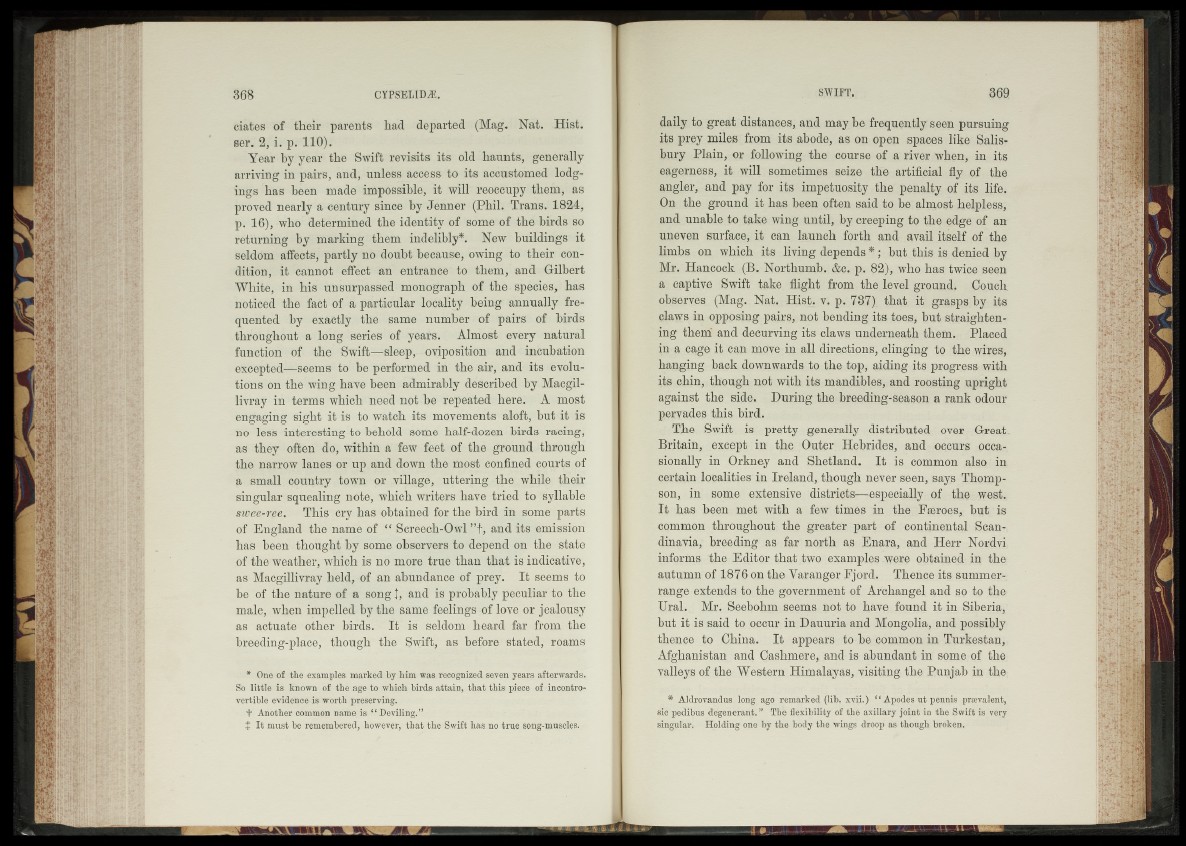
ciates of their parents had departed (Mag. Nat. Hist,
ser. 2, i. p. 110).
Year by year the Swift revisits its old haunts, generally
arriving in pairs, and, unless access to its accustomed lodgings
has been made impossible, it will reoccupy them, as
proved nearly a century since by Jenner (Phil. Trans. 1824,
p. 16), who determined the identity of some of the birds so
returning by marking them indelibly*. New buildings it
seldom affects, partly no doubt because, owing to their condition,
it cannot effect an entrance to them, and Gilbert
White, in his unsurpassed monograph of the species, has
noticed the fact of a particular locality being annually frequented
by exactly the same number of pairs of birds
throughout a long series of years. Almost every natural
function of the Swift If-sleep, oviposition and incubation
excepted—seems to be performed in the air, and its evolutions
on the wing have been admirably described by Macgil-
livray in terms which need not be repeated here. A most
engaging sight it is to watch its movements aloft, but it is
no less interesting to behold some half-dozen birds racing,
as they often do, within a few feet of the ground through
the narrow lanes or up and down the most confined courts of
a small country town or village, uttering the while their
singular squealing note, which writers have tried to syllable
swee-ree. This cry has obtained for the bird in some parts
of England the name of “ Screech-Owl ”t, and its emission
has been thought by some observers to depend on the state
of the weather, which is no more true than that is indicative,
as Macgillivray held, of an abundance of prey. It seems to
be of the nature of a song t, and is probably peculiar to the
male, when impelled by the same feelings of love or jealousy
as actuate other birds. It is seldom heard far from the
breeding-place, though the Swift, as before stated, roams
* One of the examples marked by him was recognized seven years afterwards.
So little is known of the age to which birds attain, that this piece of incontrovertible
evidence is worth preserving.
+ Another common name is “ Deviling.”
t I t must he remembered, however, that the Swift has no true song-muscles.
daily to great distances, and may be frequently seen pursuing
its prey miles from its abode, as on open spaces like Salisbury
Plain, or following the course of a river when, in its
eagerness, it will sometimes seize the artificial fly of the
angler, and pay for its impetuosity the penalty of its life.
On the ground it has been often said to be almost helpless,
and unable to take wing until, by creeping to the edge of an
uneven surface, it can launch forth and avail itself of the
limbs on which its living depends *; but this is denied by
Mr. Hancock (B. Northumb. &c. p. 82), who has twice seen
a captive Swift take flight from the level ground. Couch,
observes (Mag. Nat. -Hist. v. p. 737) that it grasps by its
claws in opposing pairs, not bending its toes, but straightening
them and decurving its claws underneath them. Placed
in a cage it can move in all directions, clinging to the wires,
hanging back downwards to the top, aiding its progress with
its chin, though not with its mandibles, and roosting upright
against the side. During the breeding-season a rank odour
pervades this bird.
The Swift is pretty generally distributed over Great.
Britain, except in the Outer Hebrides, and occurs occasionally
in Orkney and Shetland. It is common also in
certain localities in Ireland, though never seen, says Thompson,
in some extensive districts—especially of the west.
It has been met with a few times in the Faeroes, but is
common throughout the greater part of continental Scandinavia,
breeding as far north as Enara, and Herr Nordvi
informs the Editor that two examples .were obtained in the
autumn of 1876 on the Varanger Fjord. Thence its summer-
range extends to the government of Archangel and so to the
Ural. Mr. Seebohm seems not to have found it in Siberia,
but it is said to occur in Dauuria and Mongolia, and possibly
thence to China. It appears to be common in Turkestan,
Afghanistan and Cashmere, and is abundant in some of the
valleys of the Western Himalayas, visiting the Punjab in the
* Aldrovandus long ago remarked (lib. xvii.) “ Apodes ut pennis prevalent,
sic pedibus degenerant.” The flexibility of the axillary joint in tbe Swift is very
singular. Holding one by tbe body tbe wings droop as tbougb broken.